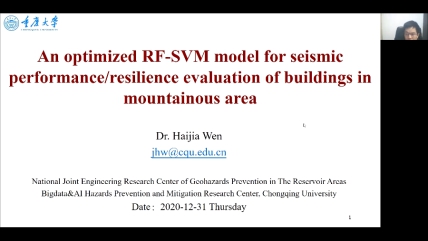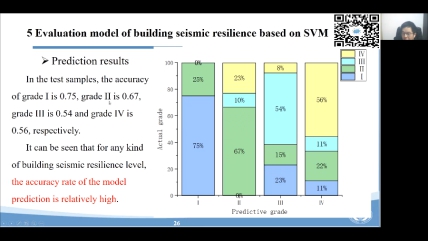On December 31, 2020, at the invitation of ISSMGE/TC303 (Coastal and river disaster mitigation and rehabilitation), Professor Wen Haijia from Chongqing University made a titled “An optimized RF-SVM model for seismic performance/relicense evaluation of buildings on mountain areas”. The academic report is an online lecture series by the International Society of Soil Mechanics and Geotechnical Engineering (ISSMGE-TC303). The webinar was hosted by Professor Chen Yumin of Hohai University. Faculty and students from Chongqing University, Hohai University, China University of Geosciences and other institutes attended the discussion.

Professor Wen Haijia combined the topography and geomorphology characteristics of western my country, and focused on the application of machine learning methods such as support vector machine (SVM) and random forest (Random Forest) in the early warning of slope engineering. This study aims to develop an optimized RF-SVM model for seismic performance evaluation of buildings in mountainous area. Professor Wen Haijia introduced to the students in detail how to use the monitoring data provided by the geological department to carry out statistical analysis and correctly select the impact factors to build a prediction model. Finally, Professor Wen Haijia compared the advantages and disadvantages of the support vector machine and random forest based on the landslides and collapses that have occurred in the southwest region.

Based on the field survey of the buildings damage in Shuanghe Town, the epicenter of Changning MS6.0 earthquake on June 17, 2019, 19 factors including seismic factors, geological conditions, topography, environmental factors and building conditions were selected as the influencing factors of seismic performance evaluation of buildings in mountainous areas. Based on the training dataset, the importance of impact factors of seismic performance evaluation of buildings was analyzed by using random forest (RF) method. On basis of factors screening by recursive feature elimination, support vector machine (SVM) was used to develop evaluation model for seismic performance of buildings. Subsequently, the accuracy of the seismic performance evaluation model was evaluated through the test data set. The results show that the seismic intensity, building curvature and seismic structure have significant influence on it. The seismic performance evaluation model of mountainous buildings based on the RF-SVM method has high accuracy, certain stability and good prediction reliability, and can improve the evaluation efficiency of damaged buildings after earthquakes.
